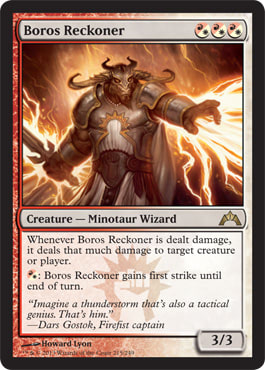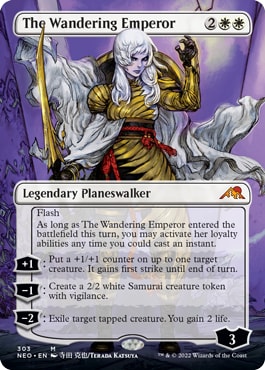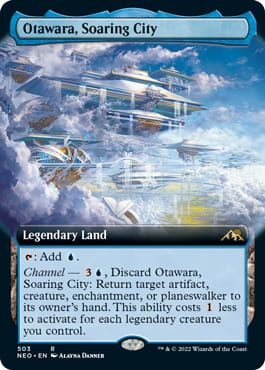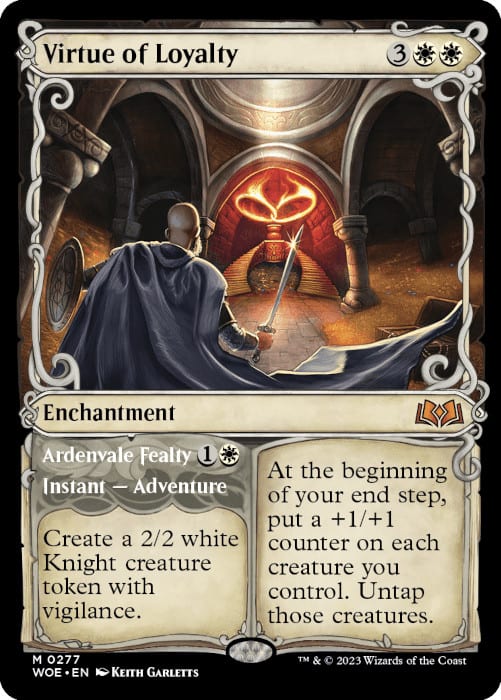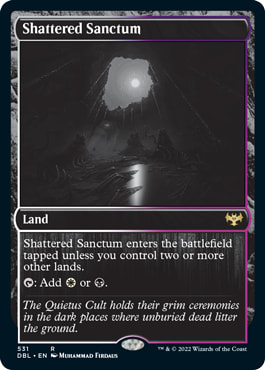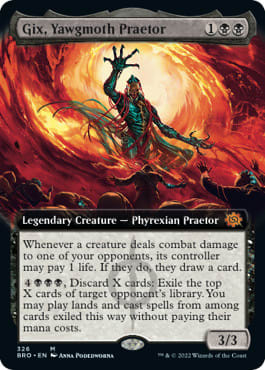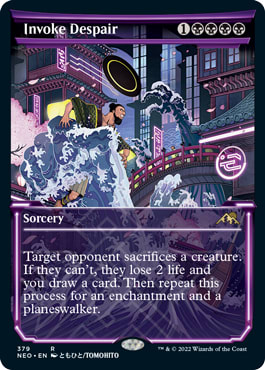If you've been a competitive Magic player in the last couple of years, you'll know that one of the biggest jokes around the scene has been Standard. It's been a really tough pill for a lot of people to swallow, with much of its support being transferred away from paper play to MTG Arena in the post-pandemic period. With Spikes around the world not investing money into Standard cards for several years, why would they want to shell out hundreds of dollars on a deck that will inevitably rotate out when they could instead buy into something like Modern or Pioneer?
Well, what if I told you that Standard was great? Even more shocking: what if I told you this was the best time to get into the format in years?
It's almost shocking to think about, but I feel strongly it's true right now more than ever. The beginning of the new year marked the start of the Standard RCQ season, providing plenty of incentive for players to find their way back in. Many grinders and content creators alike have noted that the format is extremely fun and has a surprising amount of interesting diversity to it at the moment. You don't need to look much further than CoolStuffInc's own Jim Davis talking about this very aspect just a few weeks ago and showcasing a number of cool and innovative decks.
But it's not just that the format's fun to play either. One of the big struggles Standard has had over its long history has been the way cards lose value over time. I can think of several notable cases where this happened, with cards like Hero of Bladehold, Boros Reckoner, and Rekindling Phoenix going from $15-25 cards and tanking all the way down to bulk status once they rotated out of their respective formats. No one wants to watch a high profile card like Jace, Vryn's Prodigy go from a strong $90 at its Standard peak down to $20 either. It's still a useful card, but that kind of drop is still steep nonetheless.
This sort of thing really incentivizes players to pick up older formats like Modern and Pioneer instead. The buy-in ends up being a bit higher as a result, but their decks are more likely to remain viable for a longer period of time. This isn't always the case, but if you picked up Mono-Green Tron or Amulet Titan several years ago, you can still play them today in a very similar capacity, which lends to them having serious longevity.
With this current iteration of Standard, I feel that this is less of an issue. Cards are going to hold their values longer, or otherwise, you can get them for cheap enough and still be competitive to a degree that it's irrelevant. There's three main points to this that I'd like to discuss today, starting with...
Cross-Format Compatibility
Last year I found myself buying into Pioneer a lot more. Like many, I was trying to find a way to play more competitive Magic (beyond Pauper in my case) but wanted to invest in a more non-rotating format so my decks would be viable longer. One of the decks I bought was Mono-White Humans. With it I found myself surprised that the deck had a shocking amount of similarities to Azorius Soldiers in Standard, but I decided not to pursue it because of the stigma associated with the format at the time. However, when I began picking up my cards for the Standard RCQ a few weeks ago, I noticed a lot more of this crossover again.
Let's take a look at a list of Azorius Soldiers to see what I mean.
Azorius Soldiers | LCI Standard | remf, MTGO Standard Challenge 1st Place
- Creatures (26)
- 1 Werefox Bodyguard
- 2 Hardbin, Vanguard Aviator
- 3 Tishana's Tidebinder
- 4 Knight-Errant of Eos
- 4 Lunarch Veteran // Luminous Phantom
- 4 Recruitment Officer
- 4 Resolute Reinforcements
- 4 Zephyr Sentinel
- Instants (4)
- 4 Make Disappear
- Enchantments (4)
- 4 Wedding Announcement // Wedding Festivity
- Battles (2)
- 2 Invasion of Gobakhan // Lightshield Array
Now, for comparison, here's my (out of date) Mono-White Humans list from Pioneer I used to pull cards from:
Mono-White Humans | Pioneer | Paige Smith
- Creatures (32)
- 1 Giant Killer
- 1 Kytheon, Hero of Akroas // Gideon, Battle-Forged
- 3 Brutal Cathar // Moonrage Brute
- 3 Dauntless Bodyguard
- 4 Adeline, Resplendent Cathar
- 4 Coppercoat Vanguard
- 4 Hopeful Initiate
- 4 Recruitment Officer
- 4 Thalia, Guardian of Thraben
- 4 Thalia's Lieutenant
- Instants (2)
- 2 Brave the Elements
- Enchantments (4)
- 4 Ossification
- Lands (22)
- 14 Plains
- 2 Castle Ardenvale
- 2 Eiganjo, Seat of the Empire
- 4 Mutavault
I want to be up front here and say that getting into Pioneer with Mono-White Humans probably isn't where you want to be now. The deck has fallen off tremendously with the rise of decks like Amalia Combo and Quintorius Combo, as well as the buffer provided to decks such as Azorius Control. Rather, what I'm trying to showcase here is just how comparable these decks are and how useful the cards in the Standard list are in other formats. If you picked up Mono-White Humans a year ago - like me - then you suddenly have a great starting point for Standard.
For comparison here's the number of cards I was able to convert over to the Standard list:
- 2 Eiganjo, Seat of the Empire
- 4 Recruitment Officer
- 2 Invasion of Gobakhan // Lightshield Array
- 4 Wedding Announcement // Wedding Festivity
That might not seem like much, but it accounts for roughly $100 of the ~$400 needed for the Azorius Soldiers list. Now, let's take a look at a lot of the other expensive cards in the Standard list and see what other decks they're played in across other formats:
- Tishana's Tidebinder: Played heavily in a variety of Modern decks and a handful of Pioneer ones.
- Knight-Errant of Eos: Used in Pioneer Boros Convoke and certain Amalia Combo lists.
- The Wandering Emperor: A staple of Azorius Control in Pioneer.
- Otawara, Soaring City: Free value in most Blue-based decks.
- Mirrex: Used in various Pioneer decks.
- Cavern of Souls: Essential in all kindred decks as well as a Commander staple.
- Loran of the Third Path: Used more in formats like Legacy, but also popular in Commander and Cube.
- Seachrome Coast: Used in a handful of Modern and Pioneer lists (same with all fast lands).
- Get Lost: Staple piece of removal in Pioneer and used to lesser degrees in Modern.
- Adarkar Wastes: Azorius Spirits in Pioneer and evergreen use in Commander and Cube.
That's just the money cards as well! You even can get some solid use from other cards in the deck as well. For example, Lunarch Veteran // Luminous Phantom is played in both Amalia Combo and Selesnya Angels in Pioneer. Resolute Reinforcements helps make Boros Convoke (also Pioneer) function effectively by spitting out tons of creatures fast. Even Make Disappear is another excellent piece for Azorius Control in - again - Pioneer!
Azorius Soldiers is only one example too, and one that I used primarily because it's what I found myself personally working with. A lot of this list crosses over into Esper Midrange as well, but adds a few more notables as well, chiefly Darkslick Shores (again, fast lands), Raffine's Tower (Pioneer, Commander), Takenuma, Abandoned Mire (evergreen use), and the ever useful Sheoldred, the Apocalypse.
This archetype does show a handful of pain points in areas where cards might not hold their value as much however. Take these three cards for example:
Each of these are fairly pricey cards, with Raffine going for around $6 each, Virtue of Loyalty at $18 per, and Shattered Sanctum around $22. There's also Gix, Yawgmoth Praetor in some lists who has crept up to $35 on the back of his popularity in Standard. Each of these sees minimal play in major competitive formats outside of Standard, meaning buying into them remains a risk. Yet compared to Standard periods we've seen in the past, the loss is quite a bit lower than usual. Even the particularly expensive Shattered Sanctum is going to hold some decent long term value because slow lands are outstanding in Commander, where early turns often don't have a lot going on in them.
I don't want to spend time examining every list, but here's a great list of cards in Standard now that have a tremendous amount of crossover with other formats:
- All the lands: Seriously, just about all of the lands right now have use in a large number of formats. Right now you have the Kamigawa: Neon Dynasty channel lands, the Streets of New Capenna triomes, Midnight Hunt and Crimson Vow slow lands, pain lands, allied fast lands, the Restless lands, and soon the Murders at Karlov Manor surveil temples - all of which see some degree of play in multiple formats. Oh yeah, and Cavern of Souls too, which has a tremendous amount of pedigree.
- Atraxa, Grand Unifier: Popular top-end card in a variety of formats.
- Sunfall: Played in a couple Pioneer decks, such as Lotus Field Combo.
- Leyline Binding: Popular removal spell for five-color decks in multiple formats.
- Up the Beanstalk: Great in Pioneer and Legacy, and eternally playable in Commander.
- Jace, the Perfected Mind: Modern Mill.
- Trumpeting Carnosaur: Played in Pioneer Quintorius Combo, as well as a handful of less-popular Modern lists.
- Liliana of the Veil: Beloved Modern and now Pioneer card, sees a bit less play than in the past but still great.
- Skrelv, Defector Mite: Saw play last year in Pioneer, is a bit more fringe now, likely useful in the future.
- Venerated Rotpriest: Sees play in fringe combo decks as well as Modern Infect.
- Faerie Mastermind: Played in Pioneer Rogues.
- Blossoming Turtle: Super popular among casual players.
- Virtue of Persistence: Played in several Pioneer decks.
These are just the money cards too. Much like Resolute Reinforcements and Make Disappear as mentioned above, there's plenty of key smaller cards seeing play in different formats as well, like Deep-Cavern Bat, Destroy Evil, and Bloodtithe Harvester. All this is to say that if you're worried about your buy-in backfiring, in most cases I think you'll be fine. In fact, it'll probably last you quite a bit because of my next point.
The Three Year Rotation Period
A big point in attempting to address the hurdles and struggles Standard has dealt with over the past number of years has been the change in rotation length. Thanks to this change, Standard now uses cards from three years of releases as opposed to just two. This allows for a deeper card pool, wider gameplay options, and naturally for cards to hang around longer. That last point is especially critical, because it means a buy-in now won't hurt so bad when rotation comes around.
In fact, when you look at the sets rotating this fall - Midnight Hunt, Crimson Vow, Kamigawa: Neon Dynasty, and Streets of New Capenna - the majority of key cards leaving are things like lands, The Wandering Emperor, Raffine, and smaller role-players. Most of these are either still playable in other formats and will retain most of their value because of that. Anything else are generally cheaper cards that won't hurt much even if they don't see a whole ton of play after the fact.
Now when you look at some of the pricier cards like Virtue of Loyalty and Gix, Yawgmoth Praetor whose prices are largely due to Standard demand, it's a lot more bearable to pick them up now. Gix is going to be around for a whole other year and a half, while Virtue of Loyalty still has a full two and a half years of life in it. That goes for additional cards that will inevitably see more play eventually, as I've no doubt we'll see some cards gain increased utility with a bit of time and an influx of new sets.
We also have another aspect of this longer rotation that we can examine too: bans!
To help mitigate any issues with these longer rotation periods, Wizards has noted they're committed to performing bans once a year for Standard ahead of that year's rotation. They won't always do this, but we did get one this past August to help tend to a couple cards that players were simply tired of. This got rid of Invoke Despair, Reckoner Bankbuster, and Fable of the Mirror-Breaker // Reflection of Kiki-Jiki. Every one of these cards ended up seeing decent play outside of Standard. Both Invoke Despair and Reckoner Bankbuster were never worth much, but Fable was - and it still is now! Despite being banned, it's actually held a pretty steady price with a fairly slow decline as it becomes more available from people continuing to open packs of Neon Dynasty.
Now, obviously, this won't always be the case - especially as Standard really starts to recover. You'll definitely have some instances where the banned card isn't played in other formats and as such you'll run into cases where a card has an inflated price due to Standard before crashing into oblivion. However, if the last couple years of releases are telling us anything, it's that the majority of core playables are going to be core playables in other formats for some time going forward. That's especially true with the number of strong reprints they're putting into various Standard sets, with notable recent inclusions being Liliana of the Veil and Cavern of Souls. We even have these two heaters coming right around the corner in Murders at Karlov Manor:
Because of this, you may find you already own cards that are getting reprinted into Standard. Even if you don't own them, they're extremely playable cards, so they're never going to be bad to have spare copies of in your collection. Lightning Helix has been a player in Modern Burn for over a decade and I'd be shocked - or, in this case, bolted - if it didn't make a splash in Pioneer as well.
Great Budget Friendly Decks
Last but not least, there's actually a surprising amount of budget decks that are pretty playable in the format right now as well! That's a huge boon for players not willing to shell out big bucks on the top deck. Even if these decks lose a ton of value due to their cards being unplayable outside of Standard, they're great entry points for someone to try their hand at a RCQ on the cheap.
While this could probably be a whole article on its own, I'm going to skim over three builds briefly here, starting with a classic.
Mono-Red Aggro | LCI Standard | O_danielakos, 1st Place MTGO Standard Challenge
- Creautres (21)
- 1 Feldon, Ronom Excavator
- 1 Shivan Devastator
- 1 Thundering Raiju
- 2 Phoenix Chick
- 3 Charming Scoundrel
- 3 Goddric, Cloaked Reveler
- 3 Monastery Swiftspear
- 3 Squee, Dubious Monarch
- 4 Bloodthirsty Adversary
- Instants (12)
- 1 Monstrous Rage
- 3 Witchstalker Frenzy
- 4 Lightning Strike
- 4 Play with Fire
- Enchantments (4)
- 4 Kumano Faces Kakkazan // Etching of Kumano
- Lands (23)
- 18 Mountain
- 2 Sokenzan, Crucible of Defiance
- 3 Mishra's Foundry
Good ol' Mono-Red Aggro, nothing beats that! Seriously, it's not called Red Deck Wins for nothing! This deck costs only $150 and half of that value is tied up in the playset of Bloodthirsty Adversary copies. Several cards are played in multiple formats but aren't worth much, like Lightning Strike, Monastery Swiftspear, and Squee, Dubious Monarch. This is pretty par for the course when it comes to this style of deck, though, with past Mono-Red Aggro decks getting value jumps thanks to cards like Hazoret the Fervent, Boros Reckoner, and Embercleave quickly coming to mind. It's a top deck with a price that's hard to beat, so even if the value goes down, you can get your money's worth out of it during this critical RCQ season if you don't have much money to spare.
This next one might look a little familiar to you:
Mono-White Poison | LCI Standard | ResponsiblyStupid, 43rd Place MTGO Standard Challenge
- Creatures (13)
- 1 Annex Sentry
- 4 Crawling Chorus
- 4 Jawbone Duelist
- 4 Skrelv, Defector Mite
- Instants (4)
- 1 Destroy Evil
- 3 Charge of the Mites
- Sorceries (7)
- 1 Expel the Interlopers
- 2 White Sun's Twilight
- 4 Lay Down Arms
- Enchantments (11)
- 3 Ossification
- 4 Skrelv's Hive
- 4 Tocasia's Welcome
- Lands (25)
- 17 Plains
- 4 Mirrex
- 4 The Seedcore
If you read Jim Davis' article from a few weeks ago that I linked at the top of the page, you'll probably recognize this list. In fact, despite being from a somewhat more recent event, it's the exact same list! Jim talks about the list a little more in-depth and how it plays, so if you want to read a bit more on it, I highly recommend reading through his write-up but I still wanted to highlight it because it's quite budget friendly.
While the placing is much lower here, it's still a deck that's been popping up a bit recently and it's super cheap. Barely costing over $100, most of the money is tied up in cards like Mirrex and Skrelv - both of which have multi-format utility - and Tocasia's Welcome, which will be great in casual Commander for years to come. Even if it might not be the top contender for your local RCQ, you can definitely take it to regular REL Standard events no problem, which can pave the path to up your game further from there.
There's also another cheap aggro deck in the form of all-out Gruul Aggro:
Gruul Aggro | LCI Standard | jordanlidsky, 5-0 MTGO Standard League
- Creatures (16)
- 4 Cacophony Scamp
- 4 Monastery Swiftspear
- 4 Picnic Ruiner
- 4 Questing Druid
- Instants (12)
- 4 Giant Growth
- 4 Monstrous Rage
- 4 Tyvar's Stand
- Sorceries (4)
- 4 Ancestral Anger
- Enchantments (8)
- 4 Audacity
- 4 Kumano Faces Kakkazan // Etchings of Kumano
- Lands (19)
- 4 Mountain
- 1 Boseiju, Who Endures
- 1 Rockfall Vale
- 1 Sokenzan, Crucible of Defiance
- 4 Copperline Gorge
- 4 Karplusan Forest
- 4 Thran Portal
- Sideboard (15)
- 1 Dreadmaw's Ire
- 1 Royal Treatment
- 2 End the Festivities
- 2 Strangle
- 3 Lithomantic Barrage
- 3 Urabrask's Forge
- 3 Witchstalker Frenzy
If you've played Pioneer over the last year or so, you've no doubt run into your fair share of Boros Heroic lists. This deck plays quite similarly, relying on blitzing out your opponents with fast creatures and making them massive at a blisteringly fast pace. Getting a Picnic Ruiner down with an Audacity followed by a Monstrous Rage means your opponent will be dead in record time - provided they don't have a removal spell or two to deal with it. It's a fairly fragile and budget-heavy deck, but once again it's super cheap, barely costing over $100. Most of that value is tied up in cards like Boseiju, Who Endures; Questing Druid, and Karplusan Forest - all of which are excellent multi-format cards, so that money goes to good use in the long run.
Last but not least I want to bring up another major budget friendly deck that isn't so much of an aggro deck:
Mono-Blue Tempo | LCI Standard | Sir Persson, 4-3 The Pizza Box Open
- Creatures (14)
- 2 Ledger Shredder
- 4 Picklock Prankster
- 4 Haughty Djinn
- 4 Tolarian Terror
- Instants (22)
- 1 March of Swirling Mist
- 1 Otherworldly Gaze
- 2 Essence Scatter
- 2 Negate
- 2 Thirst for Discovery
- 2 Flow of Knowledge
- 4 Consider
- 4 Fading Hope
- 4 Make Disappear
- Sorceries (2)
- 2 Chart a Course
- Lands (22)
- 22 Island
This deck has fallen out of favor tremendously, but since Dominaria United came out, it's been a popular choice for ultra budget decks. In paper, this deck can be had for just around $60 and on Magic Online it's only 13 tickets. Even on MTG Arena the list only uses 12 rares and 2 mythics, making it an easy choice if you want to get playing without burning heavy amounts of wild cards in the process. It's great for those who like a good old fashioned Delver list (many variations of this list even run Delver of Secrets itself) and several of the cards are playable in multiple formats - even if they aren't worth all that much.
The bottom line, though, is that there are tons of great ways to jump into Standard right now. You can build budget decks like this or even go all-in and know that your investment will go a long way for your gameplay for years to come in a variety of formats. Given all of this - and the timing of the current RCQ season - there's truly never been a better time to get back into the format and give it a try. If your shop is hosting a Standard event, I can't recommend giving it a try strongly enough. You'll be happy you gave it a chance again!
Paige Smith
Twitter: @TheMaverickGal
Twitch: twitch.tv/themaverickgirl
YouTube: TheMaverickGal














